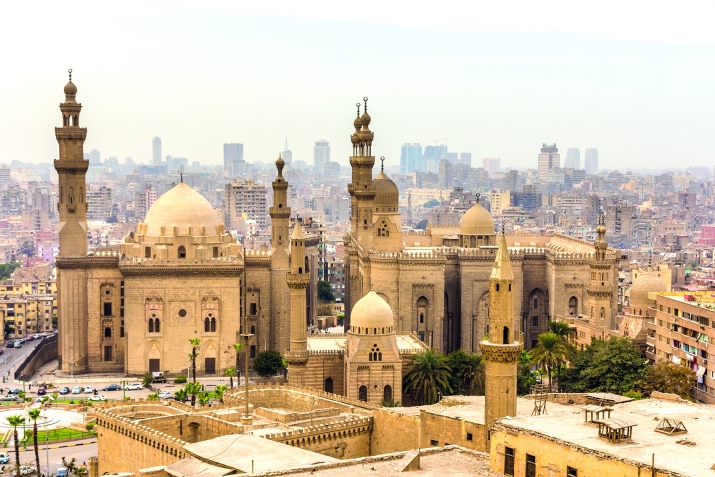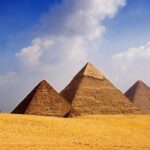– Muhammad Ali Mosque
The Mosque of Muhammad Ali is located inside the Citadel of Salah al-Din al-Ayyubi
(Saladin) in Cairo. It was built by Muhammad Ali Pasha in 1265 AH\ 1848 AD on the
site of Mamluk palaces. This mosque is known as the “Alabaster Mosque”, in
reference to its marble paneling on its interior and exterior walls. The mosque’s
twin minarets are the highest in all of Egypt, each reaching a height of 84 meters.

The mosque was built on the Turkish style that consists of an open court and prayer
hall. The prayer hall is a square space that surmounted with a large central dome
which surrounded by four semi-domes and four shallow domes in the corners.
There are two minbars (pulpits) inside the mosque.
The original of the two is made
of wood decorated in green. The other was a later addition made of marble.
The outer open court contains a copper clock tower, which was gifted to
Muhammad Ali Pasha by Louis Philippe of France in 1262 AD/1845 AD.
Muhammad
Ali Pasha reciprocated the gesture with an obelisk of Ramesses II’s (c.1279–1213
BC) that stood in front of Luxor Temple. Today, it stands in the Place de la Concorde
Square, Paris.
Limestone is the mosque’s main building material. Its square plan consists of a
central dome supported by four half.
-Sultan Hasan Mosque
The Mosque and Madrasa of Sultan Hasan is one of the largest and architecturally
exquisite mosques in all of Egypt. It was commissioned by the Mamluk sultan Hasan
ibn al-Nasir Muhammad ibn Qalawun sometime between 757 AH/1356 AD and 764
AH/1362 AD, and is located at the end of Muhammad Ali Street, opposite its
nineteenth century neighbor al-Rifa’i mosque in Salah al-Din Square.
The mosque consists of an open courtyard with fountain in its centre. The courtyard
is surrounded by four iwans (a rectangular space that is open on one side).

Doorways at the four corners of the courtyard allow access into four madrasas,
educational institutions, where the four Sunni schools of Islamic jurisprudence were
taught. Each consists of a court and iwan, in addition to the rooms of the students
and annexed service units.
The mosque has two minarets built in the Mamluk style.
Its proximity to the citadel ultimately resulted in its use as a fort by enemies
several times throughout its history, as it was used as a platform to launch attacks
on the citadel.
Like most Islamic monuments in Cairo, this one has also undergone several
phases of reconstruction, up until the twentieth century. The mosque and madrasa
are distinguished with the ornate domes, stone and plaster carved decorations, as
well as the marble works of the mihrab.
– Ahmad Ibn Tulun Mosque
The mosque of Ibn Tulun was commissioned by Ahmad Ibn Tulun (254–270
AH/868–884 AD), ‘Abbasid governor of Egypt, who in 266 AH\ 872 AD ruled Egypt
as an independent state.
Construction began in 263 AH/876 AD, and finished in 265 AH/879 AD. Located on
Jebal Yashkur (in modern-day Ahmad Ibn Tulun Square, Sayyida Zaynab), the
mosque was meant to serve as the main congregational mosque of Ibn Tulun’s new
administrative capital, al-Qata’i.
The building of this mosque was a further step in
asserting Ahmad Ibn Tulun’s independence from the ʿAbbasid Caliphate.

The mosque is distinguished by its spiral minaret, which echoes the designs of the
al-Abbas mosque in Samarra, Iraq. The arches and the windows of the mosque’s
courtyard contain stucco designs of geometric and floral designs. A water fountain is
positioned in the center of the courtyard, surmounted by a dome supported on
marble columns. The interior of the mosque contains six mihrabs. The mihrab is a
niche in the wall of a mosque that marks the qibla, the direction of the Kaaba in
Mecca, which Muslims face during prayer. The main mihrab is hollow and
elaborately decorated.
– Khan Al-Khalily
Khan El Khalili, the sprawling market/bazaar/souq in the heart of Old Cairo, is a massive
hodgepodge of old and new, from beautiful centuries-old Islamic architecture to cheap
made-in-China Ramadan lanterns with Mo Salah’s face on them. so the market is
bustling at almost all hours of the day and night, in all seasons
In the 14th century, the then-Sultan Barquq’s (his mosque is one of the 10 most

beautiful mosques in Egypt) Master of Stables, Jaharkas El Khalili, built a large
caravanserai (khan) where Khan El Khalili now stands — it was essentially a building that
housed merchants and their different goods.
In later years, other sultans added their
own khans/wekalas (another word for caravanserai) until the whole area became a
center for trade, both local and foreign, in the late 15th century.
Khan El Khalili today is an integral part of Old Cairo, and the architecture and
surrounding areas like Moez Street are reason enough to go (a UN study found that
Moez Street has the highest concentration of medieval Islamic architectural treasures in
the world). This area, called Historic Cairo
To see this and more discover our tours





